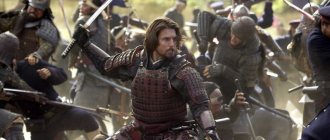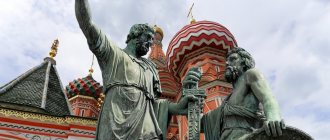Japan is a country of brave samurai and brave shoguns. The whole world knows about the valor and courage of Japanese soldiers. Samurai are an integral part of Japanese culture, its distinctive symbol. Any warrior could envy the loyalty and discipline of the samurai.
Who are they, servants of their state, desperate warriors or masters of their land?
Samurai means “warrior” in Japanese. This word also has several other meanings - “serve”, “support”, “servant”, “vassal” and “subordinate”. That is, a samurai is a warrior who serves his state and fiercely defends it.
From ancient Japanese chronicles it is known that the samurai was a nobleman (nothing in common with European nobles). They were engaged not only in military operations. In peacetime, samurai served the highest princes and were their bodyguards.
Samurai: definition of the word
In the understanding of Europeans, any Japanese warrior taking part in a battle is a samurai. In fact, this statement is completely incorrect. A samurai is a special class of feudal lords who have received a special education, undergone an initiation ritual and have a distinctive sign - a Japanese sword. The purpose of such a warrior’s life was to serve his master. He must be devoted to him with all his being and unquestioningly carry out any orders.
This goal can be seen in the very definition of “samurai”. The meaning of the word translated from Japanese is the verb “to serve.” Therefore, it is not surprising that the life of a samurai is closely connected with the life of his master - the daimyo. Many Europeans believe that a samurai is a service person who can be called by the Japanese word “bushi”. But this is also a mistaken opinion; these two words should not be confused.
The samurai has a broader and more comprehensive meaning; in wartime he represented the best protection for the master, and in peacetime he was an ordinary servant. Bushi, on the other hand, belong to the class of simple warriors who could be hired for a period of time. Payment for services was made in money, but most often feudal lords paid for the services of warriors in rice.
Sex and samurai
Sex and samurai
Sexual relationships between Japanese warriors can be called free. Approximately the same relationships took place in ancient Sparta. Same-sex relationships typically arose between more experienced samurai masters (mentors) and young warriors who were just beginning to train (novices). This practice of same-sex relationships was called wakashudo (the way of youth). Documentary evidence found suggests that almost the entire samurai class passed through the “path of youth.”
History of samurai: a brief historical background
The samurai as a class originated in the seventh century. During this period, Japan was experiencing feudal fragmentation, and every major feudal lord needed well-trained professional warriors. They became samurai.
Several centuries of internecine wars had a beneficial effect on the formation of the warrior class; by the seventeenth century they had become a numerous and fairly wealthy class. The personal samurai of the shogun, the de facto ruler of the country, were especially respected. He was the main military leader and established a strict regime in the country, with which even the emperor of the country was forced to agree, becoming only the nominal head of Japan.
By the end of the nineteenth century, when military conflicts ceased in the country, there was no longer a need for samurai. They gradually began to find new positions and occupations. Many of them found themselves in public service, others became landowners. We can say that the class has completely outlived its usefulness and remains only in romantic Japanese legends.
Personal qualities of a samurai
What a samurai should be is described in the Bushido code. We'll talk about it a little later. After all, it was formed during the heyday of samurai; until that moment, their teachers told young warriors about the personal qualities of a samurai.
The most important traits of a real samurai were considered loyalty, honesty and courage. It was from these characteristics that a warrior’s code of honor was formed, which was later transformed into bushido.
The worst thing for a warrior was to lose honor and cover himself with shame in battle. It was said about such samurai that they were not even worthy of the hara-kiri ritual - suicide by ripping open the abdomen in front of spectators. Such a warrior wandered around the country and tried to earn money like an ordinary mercenary without honor and dignity. Their services were actively used in Japan, but they treated mercenaries with undisguised disdain.
Famous samurai in history
Today it seems that samurai are characters from distant fairy tales, but in Japan they remember and honor famous warriors:
Taira no Kiyomori (1118 - 1181) the creator of the first management system and at the same time was a warrior politician who was able to suppress the uprising and become the head of 2 clans of warriors in Kyoto. Later he was able to become related to Emperor Takakura and actively participate in the transfer of the throne to his grandson.
Benkei (1155 – 1189) is a favorite of children and a hero of Japanese folklore, in which he is described as the child of a demon or even God. In history he is described as a two-meter tall and invincible warrior who did something unimaginable during every battle. The heroic death of a samurai after he remained, even dead, standing covered in wounds and arrows received the historical name “Benkei’s Standing Death.”
Hattori Hanzo (1542 - 1596) famous ninja. He first felt the taste of victory at the age of 16, and his enemies were afraid of him because they believed that he was able to disappear, foresee the future and influence the psyche of his enemies. In old age he became a monk.
Toyotomi Hideyoshi (1536 – 1598) went from a simple peasant to the second great unifier of Japan. He demanded that civilians be prohibited from carrying weapons, built many temples and actively fought against Christianity.
Oda Nobunaga (1534 – 1582) Changed the art of war by introducing the use of firearms and long pikes, and changed the warrior class system so that it was based solely on ability.
Miyamoto Musashi (1584 – 1685) is considered the greatest swordsman in Japanese history. He founded his own technique of fighting with two swords, and also wrote many books on the philosophy of war, strategy and tactics. In his life he was never defeated in a duel.
Samurai Appearance
Numerous evidence of what medieval samurai looked like has survived to this day. Over the years, their appearance has undergone virtually no changes, as have the rituals associated with the training of young warriors and their initiation into samurai.
Most often, a samurai is a man in wide trousers, reminiscent of a skirt in cut, and with a motodori hair knot. A similar hairstyle was first done to a boy during the period of initiation and subsequently accompanied him throughout his life. For this hairstyle, the forehead was shaved bald, and the remaining hair was braided into a tight knot attached to the top of the head. In addition, the samurai could wear a high headdress specially designed for motodori. The most important distinguishing feature of the samurai was the fighting sword, usually a katana.
Samurai armor
Samurai armor
Unlike the knightly armor of medieval Europe, samurai armor was created with mobility in mind; it must be very strong, but at the same time remain flexible enough so as not to restrict the warrior’s movements. Samurai armor was made of metal or durable leather plates coated with varnish. The plates were neatly tied together with leather laces. The hands were protected by shoulder pads - small rectangular shields, as well as armored sleeves.
An interesting detail of a samurai's armor is a bowl-shaped helmet, assembled from metal plates fastened together with rivets. The face was protected by armor attached to the back of the head, under the helmet. An interesting detail of the samurai headdress is the balaclava, which is very reminiscent of Darth Vader’s mask (an interesting fact is that the design of the shape of the helmet of the Star Wars movie character Darth Vader was taken from the shape of the helmet of the Japanese samurai). This piece of armor protected them from blows from arrows and swords delivered at slight angles. Masks of combat masks - mengu - were attached to the helmet, protecting the warrior and frightening the enemy.
Samurai armor and weapons
In Japanese poems, samurai are portrayed as warriors who masterfully wield the sword. In many cases this was true, but the training of a young samurai also included the use of a spear, bow and other types of swords, except for the katana. The samurai set, issued at initiation, always included two swords - a katana and a wakizashi. The ability to handle weapons was the calling card of a warrior and ensured his victory in battle.
Quite often, warriors wore armor. They were made from thin, skillfully crafted plates of leather or metal, connected to each other with strong laces. Often the plates were coated with several layers of varnish, which increased their strength. The samurai helmet completely covered the head from arrows and blows from the enemy; it was also made of flexible plates. It was quite common to decorate the helmet with brightly colored masks, which performed both protective and intimidating functions.
Loser Hero
It is curious that the main characters of the military chronicles of the early period were not the winners, but the losers. The concept of “heroic” in medieval Japan was most fully embodied by the image of Minamoto no Yoshitsune. Yoshitsune, a young man endowed with various talents and beautiful as a girl, was one of the leaders of the Minomoto clan, which fought against the house of Tairo. An interesting episode is in which Yoshitsune, resorting to military stratagem, inflicted a fatal blow on his opponent in the back.
An interesting episode is in which Yoshitsune dealt a fatal blow to his opponent in the back. Such an act, rather vile from a European point of view, in medieval Japan was regarded as part of samurai valor
Such an unethical, if not quite vile, from a European point of view, act in medieval Japan was regarded as part of samurai valor, along with such unconditional virtues as cunning and courage. However, what makes Yoshitsune a hero is not his talents as a tactician and strategist, nor his courage and amazing beauty, combined with education and ability to play the flute. Yoshitsune is a hero because, having lost the last battle, he was forced to kill his family and commit suicide. The tragedy of the hero becomes a characteristic feature of everything heroic in Japanese culture. The Japanese hero lives his life's journey rapidly: from a rapid rise to an equally rapid fall, and this predetermination of a tragic ending, a mortal battle with his own fate, turns him into a hero. Loyalty to one's life path, ideals and principles until the last breath in the Japanese worldview deserves praise and reverence.
Education and training of young warriors
Since a samurai is a feudal lord, his title was inherited in Japan. The father had to instill in his son boundless devotion to his master. All the teacher’s efforts were directed towards this.
Typically, education began at the age of eight. At this age, boys were given a small wooden sword, which was always supposed to be with him. After all, a samurai values his weapon and never parted with his sword. The future warrior was brought up in submission and respect for elders; the boy must unquestioningly follow the orders of his parents, without thinking about their righteousness. In the future, he will perceive the orders of his master in the same way.
From childhood, the future samurai is instilled with contempt for death, because in samurai philosophy his whole life is represented as just a path to a worthy end. For this purpose, teachers joined home education, they became second parents for the boy and had all the rights to him. During the learning process, the young man must become fearless, self-possessed and persistent. For such a warrior, nothing is impossible if such is the order of the master. If necessary, a samurai could happily give his life for his master, and for this he must have a sense of disdain for death. This was achieved by special methods of education.
Young warriors were often starved and forced to stay awake for several nights in a row. They did all the hard work around the house, walked barefoot at any time of the year and woke up with the first rays of the sun. To prevent death from frightening future samurai, they were often taken to watch executions, and at night they themselves had to come to the bodies of those executed and leave their mark on them. Often they were sent to places where, according to legend, ghosts live, and were left there without drink or food for several nights. As a result, the young men developed fearlessness and amazing composure; they could think soberly in any situation.
In addition to martial arts, samurai were taught writing and history, but these disciplines were not what a samurai should actually do. It was just an addition that could help in battle in one way or another.
By the age of sixteen, the young man was considered fully trained and could begin the rite of initiation and initiation into the samurai.
The Last Samurai of the Empire
After the Empire of Japan admitted defeat in September 1945, small groups of soldiers retreated into the jungles of Indochina and Indonesia still continued to resist. These soldiers received the nickname "Stragglers" from the US military, which can be translated as "stragglers" or "remainers." Many of them did not find out in time about the surrender of their country, and when they did, they refused to believe it. The reason for this was education in the spirit of samurai traditions, for whom the end of the war is victory or death.
In addition, when training soldiers in the imperial army, they were warned that “gaijin” were cunning and treacherous. They may resort to mass disinformation about the end of the war. Therefore, even having access to information about the current state of affairs in the world, these “samurai” thought that the Japanese government, which was spoken about on the radio or written in newspapers, was a puppet of the United States, and the emperor and his entourage were in exile. They perceived all events in the world from a distorted angle.
Japanese propaganda poster (https://www.taringa.net)
This fanatical devotion to the empire, which no longer existed, caused the death of some "stragglers" in clashes with local police. This article will tell the stories of three soldiers for whom World War II did not end until the 1970s. Perhaps each of you can formulate your own point of view and decide how to treat such people: as heroes, endlessly loyal to their country and traditions, or as fanatics whose minds have been thoroughly washed by the propaganda machine of militaristic Japan.
Corporal Shoichi Yokoi.
Shoichi was born on March 31, 1915 in a small village in Aichi Prefecture. He worked as a tailor before being drafted into the Imperial Japanese Army in 1941.
He was initially assigned to the 29th Infantry Division, which was stationed in Manchuria. In 1943, already as part of the 38th Infantry Regiment, he was transferred to the Mariana Islands, and in February of the same year, Shoichi and his colleagues were transferred to the island of Guam, which they were supposed to defend from the invasion of American soldiers.
Shoichi Yokoi, 1915-1997 (https://trend71.blog.so-net)
During fierce fighting, the Americans still managed to capture the island. However, the corporal, like ten other of his colleagues, did not give up. They remained true to their oath, which stated that soldiers of the empire had no right to be captured. The emperor spoke about this, the officers repeated this every day. The Guam samurai went deep into the island, to its most inaccessible part, where they found a suitable cave and decided to wait for the return of the Japanese army, without a moment’s doubt that this would happen.
Years passed, and help never came. Soon only three remained from the eleven soldiers. After a severe hurricane hit the island, the “stragglers” began to have problems with provisions. It was decided to cast lots: the one who wins will remain in the equipped cave, the other two will have to leave and look for a new shelter. The corporal was lucky, and two of his colleagues died a few days later from poisoning by the fruits of a poisonous plant. It is unknown whether they ate them by accident, or whether it was an act of ritual suicide. Be that as it may, the corporal was left completely alone. He buried his comrades in a cave, and he dug a new shelter for himself.
Over the course of eight years, Yokoi learned to hunt and fish using the most primitive tools. He went fishing at night in order not to be noticed by the local population, whom he suspected of collaborating with the enemy. His soldier's uniform had decayed, and the corporal, remembering his past life as a tailor's apprentice, made himself new clothes from what he found in the jungle.
Corporal Shoichi Yokoi holds a bag with the remains of his comrades in his hands (https://interestingengineering.com)
However, no matter how he hid, in 1972 he was noticed by two shrimp fishermen. They thought that this strange old man was a runaway peasant, so they tied him up and took him to the village. Corporal Shoichi considered himself disgraced; he could not believe that two fishermen had caught him, a loyal soldier of the imperial army. Yokoi had heard many stories from his officers about how the Americans and their allies executed their prisoners, so he thought that he was being led to the executioner.
However, it soon became clear that the war ended 28 years ago, and instead of a shameful death, the corporal would face a medical examination and return to his homeland. Before going to the hospital, Shoichi asked to be taken to a cave, where he dug up the remains of two of his comrades and put them in a bag. He did not part with it until his return to Japan. Doctors examined the corporal and found that he was completely healthy. Before being sent home, the soldier met with the Japanese consul, who answered many questions. It is said that Shoichi almost fainted when he learned that Japan and the United States were now allies, but the news that Roosevelt was long dead corrected the situation and made the emperor's soldier smile for the first time in 28 years.
The forgotten soldier who returned to his homeland was greeted as a hero - he was invited to talk shows, his feat was written about in newspapers and magazines, he was even paid a salary for the entire time that he was considered dead. A documentary film, Shoichi Yokoi and His 28 Years on the Island of Guam, was made about his life on the island. In 1991, the hero himself was honored with a reception from Emperor Akihito, who called his feat “An Act of Selfless Service to the Motherland.” Shoichi Yokoi died in 1997 at the age of 82. He was buried next to the grave of his mother, who died without waiting for her son to return.
The Corporal's Hideout is now a tourist attraction (https://interestingengineering.com)
Second Lieutenant Hiroo Onoda.
Onoda was born on March 19, 1922 into a family of teachers from the village of Kamekawa, in Wakayama Prefecture. After graduating from school in April 1939, he became an employee of the Tajima Trading Company and moved to China. There he mastered Chinese and English. In December 1942, he returned to his homeland because he was drafted into the army. Onoda was initially assigned to the 61st Infantry Regiment with the rank of Private Second Class. Then, a few days later, he was transferred to the 218th Infantry Regiment. By mid-summer, Hiroo was already a private first class, and between September and November he was promoted to private first class, and then to corporal. From January to August 1944, Onoda Hiroo studied at the army school. In December 1944, he was sent to the Philippines and appointed commander of a detachment of saboteurs.
In January 1945, already at the rank of junior lieutenant, Onodo and his detachment went to Lubang Island. Arriving at his destination, the young officer suggested that the local command begin preparing for a long-term defense, but his proposal was rejected. As a result, US Army soldiers easily defeated the Japanese and took possession of the island.
Second Lieutenant Hiroo Onoda, 1922-2014 (https://www.kentoitoh.com)
True to his oath, Onoda and his three surviving subordinates disappeared into the jungle. There they set up a base and began waging guerrilla warfare. After Japan's surrender, American planes began dropping leaflets over the jungle announcing the end of the war. Onoda, being an intelligence officer, regarded this as disinformation.
Meanwhile, in Japan, due to the lack of communication with the second lieutenant's group, the authorities declared all its members dead, but they were forced to reconsider their decision when in 1950 one of the members of the guerrilla group, Second Lieutenant Hiroo, surrendered to the Philippine authorities. Thanks to his testimony, a special commission was created to search for the “stragglers.” Due to the unstable political situation in the search area, Japanese search engines were unable to begin work for a long time. While diplomatic proceedings were ongoing, another member of the sabotage group was discovered. On May 7, 1954, in the mountains, a police detachment noticed a group of people dressed in Japanese military uniforms. An attempt to make contact with them ended in a shootout, as a result of which the second member of Onoda’s group was killed.
After this, the Philippine government gave permission to Japanese search teams to conduct their activities on the territory of Luang Island, but they were unable to find anyone. Fifteen years later, Onoda and the only one he had left to repair them were again declared dead. They were posthumously awarded the Order of the Rising Sun, VI degree. On September 19, 1972, Philippine police again exchanged fire with a group of unknown Japanese, and the last member of the group, Hiroo, was shot and killed. Another search and rescue team arrived from Japan, but this attempt also failed.
Weapons that Onoda carefully kept (https://tadtarch.269g.net)
The stubborn samurai was found only at the end of February 1974. A Japanese traveler, exploring the Philippine jungle, accidentally came across a saboteur's hideout. First, Second Lieutenant Hiroo tried to attack the intruder, but when it turned out that he was Japanese, he decided not to do so. They talked for a very long time. The researcher, whose name was Norio Suzuki, tried to persuade Onoda to lay down his arms, since the war had long ended, but to no avail. Onoda stated that he has no right to do this, since he is a soldier, and he was given an order, and until the order is canceled, he has no right to surrender.
After Suzuki returned to his homeland, the story of this meeting created a sensation, and a third search team was assembled, to which the former commander of Hiroo Onoda, Major Yoshimi Taniguchi, was invited. On the island, Taniguchi contacted Onoda and read him the order to surrender. When the junior lieutenant handed over the weapon, everyone present saw that it was in perfect condition. According to Philippine law, Hiroo faced the death penalty, since during his protracted war he killed about 30 people and wounded more than 100 more, but the Japanese Foreign Ministry settled the issue, and the officer, faithful to his oath, returned home on March 12, 1974.
Interesting fact: The return of Hiroo Onoda was met with mixed feelings by the Japanese. The majority, of course, supported the junior lieutenant and considered him a model of officer honor, but the communists and social democrats called him the “ghost of militarism” and said that he knew about the surrender of Japan, but did not surrender only because he was a complete militarist and chose to live in the jungle and kill innocent Filipinos rather than admit defeat to their country.
Private First Class Teruo Nakamura.
Nakamura was born on November 8, 1919. He was drafted into the army in 1943. The private served on the island of Morotai in Indonesia. After US troops finally defeated enemy forces in this territory in January 1945, contact between Japan and the island where Nakamura remained was lost. Teruo served in a unit whose training was equivalent to commando units, so he easily managed to avoid capture and hide in the jungle, where he built himself a shack and started a small vegetable garden in which he grew potatoes. The private believed that if they found out about his existence, they would immediately hand him over to the enemy troops, and then capture and all the horrors that the officers talked about would follow.
For almost 30 years, the private coped well with the role of the ghost of the jungle, but in 1974, the crew of an Indonesian Air Force aircraft noticed his hideout and reported him to the command. For two months, negotiations were held with the government and a plan was developed to evacuate the “straggler” soldier. No one knew how Nakamura would react to the appearance of a rescue group and whether he would believe the news of his country’s surrender.
Terou Nakamura, 1919-1979 (https://davidaldia.blogspot.ru)
On December 18, 1974, several Indonesian soldiers quietly approached the private's shack and surrounded the area to prevent an escape attempt. Then, during the Japanese national anthem, they began waving the Japanese flag. After this, Teruo himself left his home and laid down his weapon (an Arisaka rifle with five cartridges). After this, he said: “I was ordered to fight to the very end.” He was taken to Jakarta where he underwent a full medical examination. It turned out that, apart from traces of malaria, which the samurai picked up during his years of living in the jungle, he was absolutely healthy, and his physical condition was even better than that of most of his peers (in the meantime, he had turned 55 years old).
The Japanese government returned the private to his homeland in Taiwan and granted him a military pension. According to Nakamura himself, the only thing he wanted most was to return alive to his wife. However, it turned out that while he was believed to be dead, she, considering herself a widow, remarried. This may be why he lived only three years after being deported home.
Interesting fact:
Teruo Nakamura was not Japanese, he belonged to Taiwan's largest Ami people. When informed that Taiwan was no longer a Japanese or Chinese colony, he replied, "I've been a Japanese soldier for too long and I don't care that Taiwan is now a free state." By the way, his real (Taiwanese) name never became known.
Private Teruo Nakamura at a military base (https://davidaldia.blogspot.ru)
According to official information, more than a hundred Japanese soldiers who remained in Indochina after the surrender of their country joined the detachments of the Malayan communists and continued their war. In addition, in 2005, two soldiers were discovered on the territory of the Philippines, who by that time were already over eighty. They hid, fearing that they would be accused of desertion and executed. Based on this information, we can safely assume that today in the jungles of Southeast Asia there may be the remains of more than a hundred of these “stragglers” who never knew that their war was over, and the empire for whose glory they fought had already long gone.
Rite of initiation into warriors
The samurai's teacher and his future daimyo, with whom vassal relations were established, had to be present at the initiation ceremony. The ritual was accompanied by receiving one's own set of swords - daisho, shaving one's head and receiving new clothes as an adult samurai. At the same time, the young man underwent several tests that were supposed to show his strength and skills. At the end of the ceremony, he was given a new name, replacing the one given at birth. It was believed that this day was the samurai’s birthday, and under his new name he would be known throughout his independent life.
European samurai
Ancient Japanese chronicles say that under special conditions, a non-Japanese person could easily fight alongside the samurai, and becoming one of the samurai was considered a special honor. Such a warrior was given weapons and armor, and was also called a new name, Japanese. This honor could only be bestowed by very powerful leaders, such as the daimyo, or by the person who actually ruled Japan for most of the time - the general, that is, the shogun.
In history there is a mention of four men who had the honor of receiving the title of samurai:
The English navigator and the first Briton to reach the shores of Japan, William Adams, also known as Miura Anjin, played a vital role in the development of trade relations between Japan and Holland and Japan and England.
Dutch navigator and merchant Jan Joosten van Lodestein, known as Yayosu, acted as adviser to the shogun Tokugawa Ieyasu on foreign policy and trade issues.
French naval officer Eugene Collache also took the title of samurai. Japanese name unknown. Upon arrival in France, he was dismissed by court martial as a deserter. He wrote the book Adventures in Japan 1868-1869, which was published in 1874.
Dutch by birth and arms dealer Edward Schnell, Japanese name Hiramatsu Buhei. He was a military instructor and weapons supplier for the Japanese.
Could a commoner become a samurai?
The legend of the samurai, who belongs to the upper class of Japanese society, has the totality of all positive qualities and is crystal clear in thoughts, is firmly entrenched in the European imagination. In fact, this is the most common myth about feudal warriors. After all, in reality, a samurai is not necessarily a person from high society; absolutely any peasant could become a warrior. There was no difference between the origins of the samurai; they were trained in the same way and subsequently received absolutely equal salaries from the master.
Therefore, samurai changed their masters quite often, feeling that they were losing the battle. It was quite normal for them to bring the head of the old one to the new master, thus deciding the outcome of the battle in their favor.
Samurai clothing
Samurai clothing
Samurai were, in a sense, standards, and the style of their clothing had a significant influence on the fashion of an entire era. Samurai almost never dressed outrageously. All of their clothing was designed to fit the needs of a warrior. It was intended for freedom of movement and should not restrict movement.
The samurai's clothing consisted of several basic elements: hakama (wide trousers, similar to bloomers), kimono (traditional clothing in Japan, usually silk), and hitatare (a kind of cape, ceremonial clothing that was worn under armor). This suit did not restrict movement and left your hands free. For footwear, samurai wore boots made of wood and simple sandals.
Perhaps the most characteristic feature was the samurai's hairstyle - hair collected in a bun. This may be due to the fact that wearing a helmet with this hairstyle is more convenient.
Women samurai: myth or reality?
In historical sources and Japanese literature of the Middle Ages, practically nothing is mentioned about women warriors, but they quite often became samurai. There were absolutely no restrictions on this in the code of honor.
Girls were also adopted from their families at age eight and initiated at sixteen. As a weapon, a samurai woman received from her teacher a short dagger or a long and sharp spear. In battle, it was capable of cutting through enemy armor with ease. Studies by Japanese scientists indicate the popularity of military affairs among women. They did a DNA test on the remains of samurai who died in battles found at excavations; to their surprise, 30% of the warriors turned out to be women.
Samurai in modern culture
Samurai in Japan today remain an example of a unique personality, combining the traits of a brave warrior, a sophisticated poet and an inspired artist who was not afraid to die in battle and was able to leave a magnificent dying poem, committing ritual suicide.
The active penetration of Eastern culture into the Western world made it possible to place this image on the pages of books, in films, and of course was reflected in the anime culture, giving rise to various manga, cartoons and embodied in stylized costumes.
Bushido Code: Brief Provisions
The samurai code of conduct was formed from numerous laws and regulations that were compiled into a single source around the thirteenth century. During this period, samurai were just beginning to emerge as a separate class of Japanese society. By the sixteenth century, Bushido had finally taken shape and began to represent the true philosophy of the samurai.
The warrior's code covered almost all areas of life, each with its own special rule of behavior. For example, according to this philosophy, a samurai is one who knows exactly how to live and die. He is ready to boldly go alone against a hundred enemies, knowing that death awaits him ahead. Legends were made about such brave men; their relatives were proud of them and placed portraits of samurai who died in battle in their houses.
The samurai's code of honor ordered him to constantly improve and train not only his body and mind, but also his spirit. Only a strong spirit could be a warrior worthy of battle. If ordered by the master, the samurai had to commit hara-kiri and die with a smile and gratitude on his lips.
In Japan, the story of the samurai is still successfully used; it brings fabulous money to the country’s tourism industry. After all, Europeans romanticized everything connected with this period in the country’s history. Now it is difficult to find grains of truth among the numerous legends, but one thing is quite difficult to argue with: the samurai is as bright a symbol of modern Japan as a kimono or sushi. It is through this prism that Europeans perceive the history of the Land of the Rising Sun.
Loyalty is not a virtue
After the Ashikaga's relatively quiet reign had passed, Japan was once again rocked by civil war that lasted nearly a century. During this difficult period for the country, no large-scale literary works were created describing the image of the samurai, but household laws and regulations of individual families and principalities appeared, which contained ideas on how to live, practical recommendations, quotes from various Confucian and Buddhist texts.
Since the samurai was deprived of the opportunity to show sensual love for his overlord, as he could have done in relation to his beloved, he had to sacrifice his life, wealth and interests for the sake of his master
During the period of civil war, pragmatism begins to dominate in the samurai's worldview, and the main valor becomes the ability to win, and it does not matter at what cost. If victory is achieved through betrayal and meanness, that’s good. One of the most successful commanders of this period wrote in his instructions: “It doesn’t matter what the samurai will be called, a tiger or a dog, it is important that the samurai wins.” Since loyalty to one's overlord ceased to be the highest virtue, this circumstance served as a reason to develop clear instructions on how to rule well and how to serve well (before this, the question of the differences between higher and lower ranks was of little interest to the samurai).
The master from now on had to be attentive to the needs of his vassal, so that he would not be betrayed at the most crucial moment. It was possible to “insure” the loyalty of your vassal, for example, by rewarding him with land after each successful campaign, or by holding his family hostage. The emergence of a dialogical socio-economic space between vassal and master, between the peasant, on whose fields battles were fought, and the samurai, led the latter to the idea of the need to learn to balance between peace and war. From now on, “the art of war should be the right hand of the samurai, and the art of peace - the left.” The samurai begins to learn to be not only a warrior, but also an educated administrator. And since in Japan of that period the only science of management was Confucianism, the “art of peace” for the samurai became the study of Confucian texts. By the 17th century, this led to a semantic change in the hieroglyph for the word "samurai". Instead of “ji” - servant, subordinate, the hieroglyph “si” came into use, denoting not only a warrior, but rather an administrator, a person in the service, first of all, of the state.











